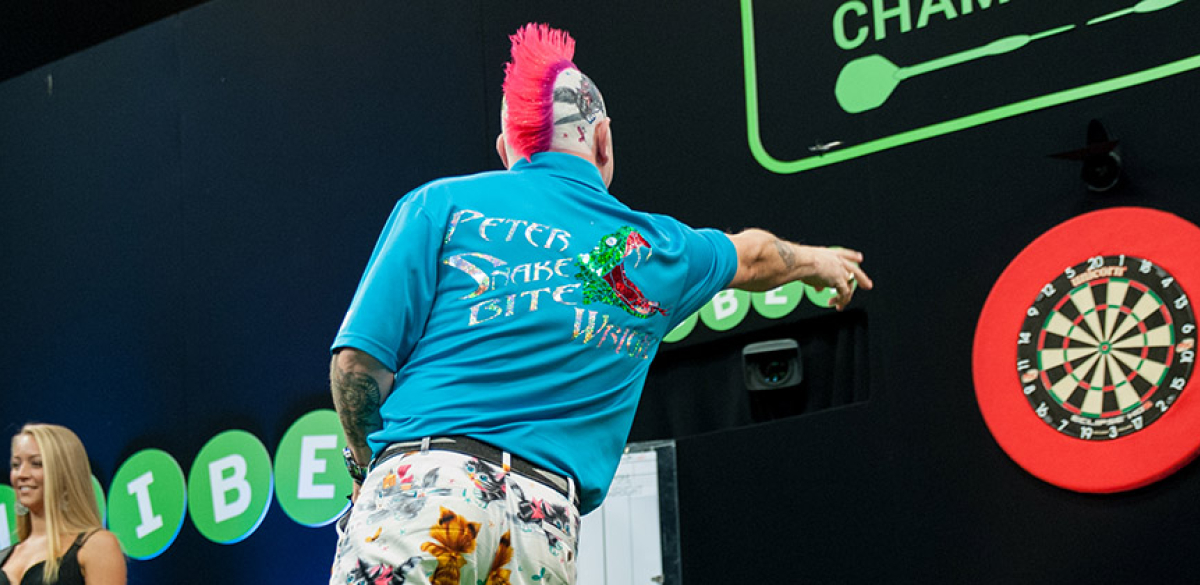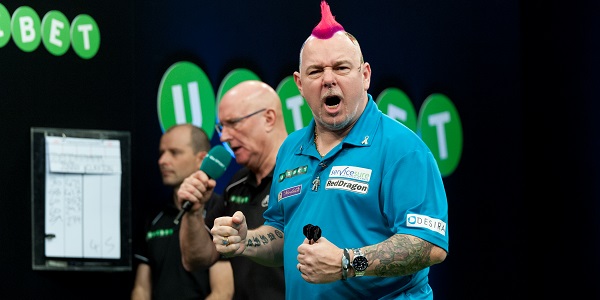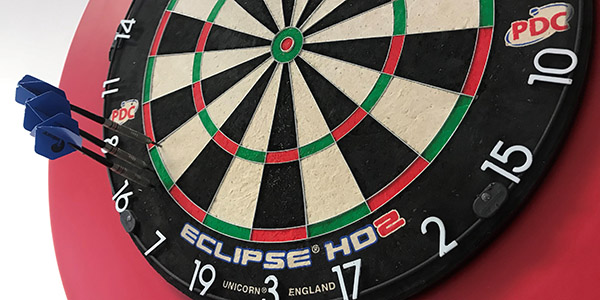
Christopher Kempf, the statistical analyst of the PDC, takes a look at how pressure affects a player's performance.
The key moment of Peter Wright's victory at Players Championship 14 came in a last-leg decider in the semi-final against Jermaine Wattimena.
With the Dutchman waiting on a score of 80, Wright needed to take out a 161 finish to keep his hopes of winning his first title of 2018 alive.
But the prospect of landing the fourth highest checkout in darts was hardly a daunting one for the world number two as he shocked Wattimena with the 1.6% shot.

Had Wattimena returned to the board in that leg, the PDC-wide three-dart checkout probability of taking out 80 (35.4%) suggests he would have stood an excellent chance of reaching the final if he got a shot at it.
If ‘The Machine Gun’ had been waiting on a score of 32 rather than 80, he certainly would have improved his own odds of winning had Wright missed the 161.
But what effect would an easier set-up from Wattimena have had on Wright's checkout probability? Would Snakebite have been emboldened by the prospect of crushing his opponent's hopes with a huge finish? Or would he have viewed a Wattimena triumph as nearly inevitable and let it affect his accuracy?
The core question is this - how much effect does a player's ability to pressurise their opponent really have on their opponent's throw?
Without asking a player directly, it's difficult to know whether pressure causes players to consciously behave differently.
Given that a darts player is almost always in a position to profit from finishing the leg in as few darts as possible (with the exception of attempting bullseye checkouts in a handful of situations), a player can ignore his opponent's performance entirely and make almost exactly the same strategic decisions as they would if they were aware of every point being chalked up by their opponent.
An elite player such as Peter Wright might be inclined to go for the bullseye on a 161 finish, regardless of his opponent's score, or even whether or not that opponent could finish in the next turn at all.
Do players take more time or miscount more often when they are under pressure? A data set of sufficient comprehension and size to analyse those questions does not yet exist.
| Opponent on | ||||||
| 1 dart checkout | 2 dart checkout | 3 dart checkout | No finish | |||
| 2-40 even | 3-39 odd, 41-98, 100 | 99, 101-170 | 159, 162-3, 165-6, 168-9, 171-501 | |||
| Attempted finish | 3 dart checkout | 99, 101-170 | 11.00% | 10.86% | 10.04% | 6.32% |
| 2 dart checkout | 3-39 odd, 41-98, 100 | 46.25% | 45.56% | 44.62% | 38.95% | |
| 1 dart checkout | 2-40 even | 71.48% | 71.90% | 74.37% | 74.05% | |
What we can learn from the data is the overall trend of checkout probabilities for particular categories of finishes as an opponent attempts easier finishes.
From the dataset of 160,000+ visits recorded in the first 14 Players Championship events of 2018, consider a player attempting a checkout of 99 or between 101 and 170 - the set of finishes for which a player can only secure one dart at double in a visit.
With the opponent not on a finish, the checkout probability is low (6.32%) and thus a player feels little urgency in finishing such a score within the visit.
The finishing probability jumps dramatically to 10.04% when the opponent waits to attempt a one-double finish of their own, and rises steadily to 11% when the opponent has three darts at a double with which to win the leg.
A player will complete one additional 121 checkout (for instance) per 100 attempts when put under maximum pressure than when they are facing only a 5% chance of losing the leg in the next visit.
But lest a player think that scoring less will lure an opponent into a false sense of security. It is, on the contrary, far more advantageous to attempt an easier checkout than to bank on the few tenths of a percent by which an adversary's checkout probability declines when under less pressure.

For the two-dart (two-double-maximum) checkouts (3-39 odd, 41-98, 100), the trend is very similar; while only 38.95% of these finishes are completed when the opponent is not on a finish, that percentage leaps up to 44.62 when the opponent is on a three-dart, one-double finish and continues to increase to 46.25 in a three-darts-at-double scenario.
However, when attempting the easiest checkouts in darts (2-40 even), pressure becomes acutely felt.
From a checkout percentage of over 74% when the opponent is waiting on a 100+ finish, the probability drops to 71.48% when the opponent is waiting to throw three darts at a double of his own.
With the odds of losing the leg growing as the opponent gets closer to the winning double, players struggle more and more to stave off that impending challenge.
So, which players are the best at working under pressure? We can analyse this by comparing, for instance, the checkout probabilities of players attempting finishes of 2 through to 98 and 100 when their opponents are on a similar score, compared to their overall checkout rate of those finishes.
| 1- and 2-dart checkout rate, with opponent waiting on 1- or 2-dart finish | 1- and 2-dart checkout overall rate | Checkout rate improvement under pressure (% points) | |
| Darren Webster | 69.61% | 61.19% | 8.42% |
| Robert Thornton | 62.04% | 55.56% | 6.49% |
| Stephen Bunting | 63.18% | 57.43% | 5.75% |
| Gabriel Clemens | 68.54% | 63.01% | 5.53% |
| Jan Dekker | 73.05% | 67.94% | 5.11% |
| Kyle Anderson | 58.97% | 54.63% | 4.35% |
| Michael Barnard | 64.97% | 60.75% | 4.22% |
| Rob Cross | 68.81% | 64.78% | 4.03% |
| Cristo Reyes | 57.86% | 53.97% | 3.89% |
| Simon Whitlock | 62.92% | 59.07% | 3.85% |
| Ricky Evans | 63.07% | 59.23% | 3.83% |
| Jelle Klaasen | 53.93% | 50.20% | 3.73% |
| Nathan Aspinall | 64.00% | 60.27% | 3.73% |
| Jamie Lewis | 67.95% | 64.45% | 3.49% |
| Kim Huybrechts | 56.72% | 53.27% | 3.45% |
| Steve West | 62.25% | 59.11% | 3.14% |
| Michael van Gerwen | 69.23% | 66.18% | 3.05% |
| Mark Webster | 60.99% | 57.97% | 3.02% |
| Brendan Dolan | 68.90% | 66.09% | 2.82% |
| Adrian Lewis | 64.29% | 61.52% | 2.77% |
| Josh Payne | 58.73% | 56.00% | 2.73% |
| Ron Meulenkamp | 62.67% | 60.00% | 2.67% |
| Ryan Joyce | 68.45% | 65.96% | 2.49% |
| Luke Woodhouse | 59.64% | 57.21% | 2.43% |
| Peter Hudson | 57.14% | 54.87% | 2.27% |
| Steve Beaton | 64.20% | 61.92% | 2.27% |
| Gary Anderson | 62.81% | 60.57% | 2.24% |
| Daryl Gurney | 63.58% | 61.54% | 2.04% |
| Simon Stevenson | 60.42% | 58.44% | 1.98% |
| Mickey Mansell | 58.99% | 57.06% | 1.93% |
| Adam Hunt | 55.77% | 53.93% | 1.84% |
| Benito van de Pas | 53.21% | 51.36% | 1.84% |
| James Wade | 66.99% | 65.19% | 1.80% |
| Keegan Brown | 60.80% | 59.03% | 1.78% |
| Michael Smith | 68.98% | 67.24% | 1.74% |
| James Wilson | 59.45% | 57.77% | 1.68% |
| Richard North | 57.14% | 55.61% | 1.53% |
| Jermaine Wattimena | 68.06% | 66.56% | 1.51% |
| Danny Noppert | 59.61% | 58.16% | 1.44% |
| Jeffrey de Zwaan | 58.71% | 57.32% | 1.39% |
| Alan Tabern | 59.31% | 57.99% | 1.32% |
| Alan Norris | 56.92% | 55.68% | 1.25% |
| Matthew Edgar | 56.43% | 55.19% | 1.24% |
| Tytus Kanik | 53.52% | 52.40% | 1.12% |
| Ian White | 58.58% | 57.61% | 0.97% |
| Joe Cullen | 53.38% | 52.55% | 0.83% |
| Dimitri Van den Bergh | 60.00% | 59.31% | 0.69% |
| Dave Chisnall | 60.83% | 60.22% | 0.62% |
| Stephen Burton | 64.35% | 63.84% | 0.51% |
| Jonny Clayton | 59.80% | 59.38% | 0.43% |
| Gerwyn Price | 61.54% | 61.18% | 0.36% |
| Paul Nicholson | 60.00% | 59.88% | 0.12% |
| Jeffrey de Graaf | 62.66% | 62.56% | 0.10% |
| Rowby-John Rodriguez | 59.03% | 59.02% | 0.00% |
| Mervyn King | 57.93% | 57.94% | -0.01% |
| Jimmy Hendriks | 58.59% | 59.09% | -0.50% |
| Peter Wright | 62.61% | 63.31% | -0.70% |
| John Henderson | 59.11% | 59.88% | -0.76% |
| Steve Lennon | 55.91% | 56.84% | -0.94% |
| Mensur Suljovic | 56.52% | 57.61% | -1.09% |
| Chris Dobey | 56.05% | 57.27% | -1.22% |
| Martin Schindler | 60.34% | 62.35% | -2.00% |
| Vincent van der Voort | 53.33% | 57.45% | -4.11% |
In this respect, no player is more impressive than Darren Webster, who demolishes players at a rate of 69.61% while under pressure, 12.1% more often compared to his overall expected finishing rate for those checkouts.
SET!
— PDC Darts (@OfficialPDC) December 27, 2017
Darren Webster is running away with this Second Round game as he moves into a three-set lead without reply! #LoveTheDarts #WHDarts pic.twitter.com/LdjzSGW3S0
Jan Dekker, Stephen Bunting, Gabriel Clemens and Robert Thornton also excel at similar rates. At the other end of the table is Vincent van der Voort, who is 7.7% less likely to finish under pressure than overall.
The general outcome of this analysis is that pressure affects players differently depending on the difficulty of the finish being attempted.
Challenging finishes become opportunities for unexpected success, while simple ones seem to escalate competitors' anxiety and instil a fear of failure.
The percentages at issue in a broader statistical context are relatively small, but the psychological stresses, rewards and injuries caused by these scenarios can be enormous.
For Wright, they must have been; facing another disappointing last-leg defeat, his 161 finish resulted in a reboot of his 2018 campaign and a first title of the year, all owed to grace under pressure in a single visit.